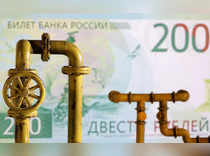 Reuters
ReutersAlthough a correction was witnessed in several other commodities, natural gas prices remain unchanged. Restricted supplies from the world’s largest gas exporter, Russia, continued to hang over the market.
Gas prices at various international markets have doubled or tripled the price since the start of the year. The US NYMEX gas futures gained over 110 per cent since January. Meanwhile, the European benchmark, TTF gas has jumped a whopping 380 per cent in the same period.
Russia has been facing several economic sanctions from the US and European Union after its inversion of Ukraine. This includes freezing the assets of the Russian central bank, barring Russian banks from international transactions, and limiting imports of Russian oil and gas. The European Union also announced plans to reduce demand for Russian gas by two-thirds and make Europe independent from Russian fuels by 2030.
Russia is the world’s leading gas exporter and has the largest gas reserves in the world. Russia supplies a significant volume of fossil fuels to many European countries. Almost 40 per cent of the gas that comes to European countries is from Russia. This has given Russia significant leverage for using gas as a geopolitical weapon.
Since the beginning of the war, Russia has been limiting gas supplies to many European countries. Due to restrictions on international trades, Russia demanded their payments in Russian Ruble. Countries like Poland, Bulgaria, Finland, Netherlands, and Denmark have denied the order, and Russia cut off supplies to these countries.
The amount of gas coming from Russia to Europe is currently less than a third of the same period last year. In a recent move, Russia’s Gazprom, the state-run Russian energy giant, drastically cut gas deliveries to Europe through the Nord Stream 1 pipeline. This has resulted in European gas futures prices quadrupling compared to the pre-war period.
Currently, the pipeline carries only 20 per cent of its actual capacity. Nord Stream 1 pipeline stretches under the Baltic Sea from Russia to north-eastern Germany, through which the country meets most of its energy needs. The energy crunch in Germany has also plunged Europe’s economy into its worst energy crisis since 1973.
To beat the Russian chokehold on gas supplies, Europe is looking everywhere for energy to keep its economy running. Measures like reviving coal field power plants, spending billions on terminals to bring LNG from the US, and discussions with other gas majors to nail down energy deals are likely to reduce the dependence on Russian gas. However, although the current storage levels give some comfort to the region, concerns are still mounting as the cold weather approaches.
The current price uncertainty is likely to persist in the near future. Although Europe is looking for several backup plans for Russian energy, it is unclear whether it is possible before the winter season. If Europe fails to find a permanent replacement solution on time, Europe’s economy may have to suffer. It could push the block into a recession, as inflation has been at its highest level since 1997.
(Hareesh V is the Head of Commodities at Geojit Financial Services)
Download The Economic Times News App to get Daily Market Updates & Live Business News.
Subscribe to The Economic Times Prime and read the Economic Times ePaper Online.and Sensex Today.
Top Trending Stocks: SBI Share Price, Axis Bank Share Price, HDFC Bank Share Price, Infosys Share Price, Wipro Share Price, NTPC Share Price
Read More News on
Download The Economic Times News App to get Daily Market Updates & Live Business News.
Subscribe to The Economic Times Prime and read the Economic Times ePaper Online.and Sensex Today.
Top Trending Stocks: SBI Share Price, Axis Bank Share Price, HDFC Bank Share Price, Infosys Share Price, Wipro Share Price, NTPC Share Price












 Get Unlimited Access to The Economic Times
Get Unlimited Access to The Economic Times
